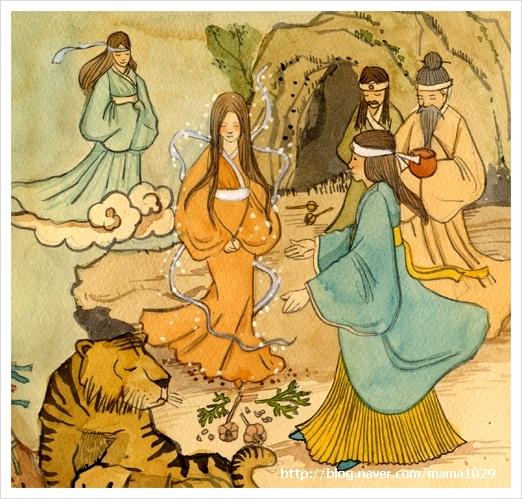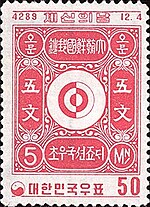Dangun
From Wikipedia, the free encyclopedia
For other uses, see Dangun (disambiguation).

| Dangun | |
|---|---|
| Hangul | 단군왕검 |
| Hanja | 檀君王儉 |
| Revised Romanization | Dangun Wanggeom |
| McCune–Reischauer | Tan'gun Wanggŏm |
Dangun Wanggeom, or Tangun, was the legendary founder of Gojoseon, the first Korean kingdom, around present-day Liaoning, Manchuria, and the Korean Peninsula. He is said to be the "grandson of heaven", and to have founded the kingdom in 2333 BC. The earliest recorded version of the Dangun legend appears in the 13th century Samguk Yusa, which cites China's Book of Wei and Korea's lost historical record Gogi (古記).
[edit] Legend
| This article is part of a series on the |
| History of Korea |
|---|
 |
| Prehistory |
| Jeulmun period |
| Mumun period |
| Gojoseon ?–108 BC |
| Wiman Joseon 194 BC–108 BC |
| Proto–Three Kingdoms 300–57 BC |
| Buyeo, Goguryeo, Okjeo, Dongye |
| Jin state, Samhan (Ma, Byeon, Jin) |
| Four Commanderies of Han |
| Three Kingdoms 57 BC–668 |
| Goguryeo 37 BC–668 |
| Baekje 18 BC–660 |
| Silla 57 BC–935 |
| Gaya 42–562 |
| North and South States 698–926 |
| Unified Silla 668–935 |
| Balhae 698–926 |
| Later Three Kingdoms 892–936 |
| Taebong, Hubaekje, Silla |
| Goryeo 918–1392 |
| Joseon 1392–1897 |
| Korean Empire 1897–1910 |
| Colonial Korea 1910–1945 |
| Provisional Gov't 1919–1948 |
| Division of Korea 1945–present |
| North Korea 1948–present |
| South Korea 1948–present |
| By topic |
| Timeline |
| List of monarchs |
| Linguistic history |
| Science and technology history |
| Art history |
| Military history |
| Naval history |
Dangun's ancestry legend begins with his grandfather Hwanin (환인; 桓因), the "Lord of Heaven". Hwanin had a son, Hwanung, who yearned to live on the earth among the valleys and the mountains. Hwanin permitted Hwanung and 3,000 followers to descend onto Baekdu Mountain, where Hwanung founded Sinsi (신시; 神市, "City of God"). Along with his ministers of clouds, rain, and wind, he instituted laws and moral codes and taught humans various arts, medicine, and agriculture.[1] Legend attributes the development of acupuncture and moxibustion to Dangun.[2]
A tiger and a bear prayed to Hwanung that they may become human. Upon hearing their prayers, Hwanung gave them 20 cloves of garlic and a bundle of mugwort, ordering them to eat only this sacred food and remain out of the sunlight for 100 days. The tiger gave up after about twenty days and left the cave. However, the bear remained and was transformed into a woman.
The bear-woman (Ungnyeo; 웅녀; 熊女) was grateful and made offerings to Hwanung. However, she lacked a husband, and soon became sad and prayed beneath a "Sindansu" (신단수; 神檀樹, "Divine Betula") tree to be blessed with a child. Hwanung, moved by her prayers, took her for his wife and soon she gave birth to a son, who was named Dangun Wanggeom.
Dangun ascended to the throne, built the walled city of Asadal, situated near Pyongyang (the location is disputed) and called the kingdom Joseon—referred to today as "Old/Ancient Joseon" (Korean: "Gojoseon") so as not to be confused with the Joseon kingdom which occurred much later. He then moved his capital to Asadal on Mount Baegak (or Mount Gunghol).
[edit] Dating
Emperor Dangun's rule is usually calculated to begin in 2333 BC, based on the description of the Dongguk Tonggam (1485) contemporary to the 40th year of the reign of the legendary Chinese Emperor Yao. Other sources vary somewhat, but also put it during Yao's reign (traditional dates: 2357 BC-2256 BC). Samguk Yusa states Dangun ascended to the throne in the 50th year of Yao's reign, while Sejong Sillok says the first year and Dongguk Tonggam says the 25th year.
Until 1961, the official South Korean era (for numbering years) was called the Dangi (단기, 檀紀), which began in 2333 BC. Daejonggyo considered October 3 in the Korean calendar as Gaecheonjeol (개천절, 開天節, "Festival of the Opening of Heaven"). This day is now a national holiday in the Gregorian calendar, called National Foundation Day.
North Korea dates Dangun's founding of Gojoseon to early 30th century BC.[3]
15 March in the year 4340 of the Dangun Era is called Eocheonjeol Ceremonies (어천절,御天節), the day that the semi-legendary founder Dangun returned to the heavens, continuing a tradition that has been passed down through the generations without interruption.
[edit] Appearances
The earliest recorded version of the Dangun legend appears in the 13th century Samguk Yusa, which cites China's Book of Wei and Korea's lost history text Gogi (古記). This is the best known and most studied version, but similar versions are recorded in the Jewang Un-gi by the late Goryeo scholar Yi Seung-hyu (이승휴, 李承休, 1224-1300), as well as the Eungje Siju and Sejong Sillok of the early Joseon dynasty.
Scholars today regard the legend as reflecting the sun-worship and totemism common in the origin myths of Northeast Asia. The bear is often found in origin myths of Manchuria and Russian Far East. The legend therefore may hint at the relationships among various tribes that worshipped the sun, bear, and tiger.
Simply re-interpreted, the legend can become this:
" Around the time of Emperor Yao's reign in China, a tribal nation which worshipped the sun grew strong and began to incorporate other primitive Korean tribes and began to build a confederacy of tribes. One group, worshipping the bear as its totem, was incorporated. Another, which worshipped the tiger, was excluded from this union. From the union of the Sun tribe (in the legend, Shinshi) and the Bear tribe, Dangun Wanggeom was born, and Dangun later founded a nation, and named it Joseon. His descendants ruled Joseon until the rebellion of Wiman, or, despite controversy, until the arrival of Gija."
It is widely accepted by present-day historians that at the time of Dangun's reign, his status was deified by placing him in the position of the Grandson of Heaven, and thus, strengthened Dangun's position as the head of a confederacy.
The story further illustrates the importance of knowledge of weather to the early agricultural peoples of Korea.
[edit] In Korean shamanism
During the late Goryeo era, the Dangun legend is thought to have played an important role in national unity and patriotic mobilization against the invaders. Gosindo (고신도; 古神道), a version of Korean shamanism that considered Dangun a god, had a small following, but had largely died out by the 15th century.
In the late 19th and early 20th centuries, with a resurgence in Korean nationalism after repeated outside foreign incursions and the beginning of colonial rule in 1910 to 1945, the movement was revived in Daejonggyo (대종교; 大宗敎). It was promoted by Na Cheol (1864-1916), but could not survive the repression under the occupation (Taejonggyo (1999)/Tangun), since it conflicted with the Japanese cultural imperialism policy. After the liberation of Korea, Daejonggyo was revived, although it remains a minor religion.[4]
Dangun is worshipped today as a deity by the followers of Cheondogyo, and Daejonggyo.
[edit] In Taekwondo
Dangun is the second pattern or tul in the ITF form of the Korean martial art taekwon-do. Students learn that the tul represents "the holy legendary founder of Korea in the year 2333 BC." Unusually for a tul, all the punches in Dangun are high section (nose level) symbolising Dangun scaling a mountain. see Dan-Gun Hyung.
[edit] Mausoleum of Dangun
The Mausoleum of Dangun is the alleged burial site of the legendary Dangun. The site occupies about 1.8 km² (.70 mi²) on the slope of Taebak Mountain (대박산) in North Korea. Dangun's grave is shaped like a pyramid, about 22 m (72 ft) high and 50 m (164 ft) on each side. Many observers and historians outside of North Korea, including South Korea, consider the site controversial.
[edit] See also
[edit] References
- ^ The Story of Dan-gun
- ^ Needham, J; Lu GD (2002). Celestial lancets: a history and rationale of acupuncture and moxa. Routledge. pp. 262. ISBN 0-7007-1458-8.
- ^ KCNA
- ^ Adherents
[edit] Further reading
- DPRK Academy of Social Sciences, "Tangun Founder King of Korea", Foreign Languages Publishing House, softcover, 168 pages
[edit] External links
- The Legend of Tan-Gun
- Myth of Korea: Tangun
- Korean Myths and Tales
- The T'angun Legend[dead link]
- Korean Tales in French
| Preceded by none | Rulers of Gojoseon 2333 BC – 2240 BC | Succeeded by King Buru |

댓글 없음:
댓글 쓰기